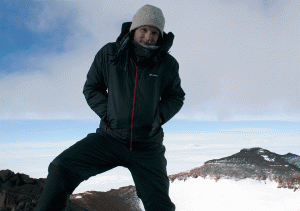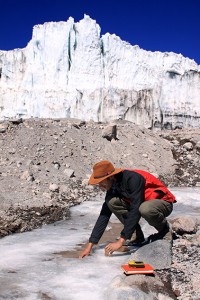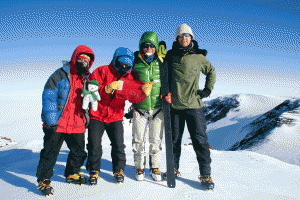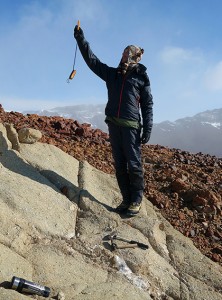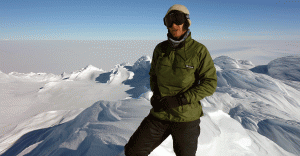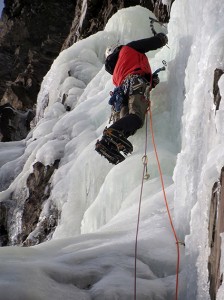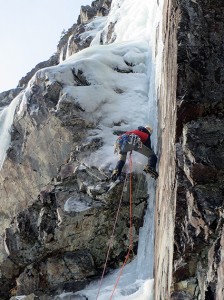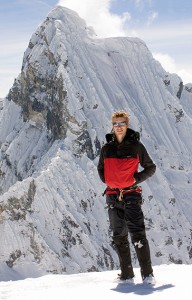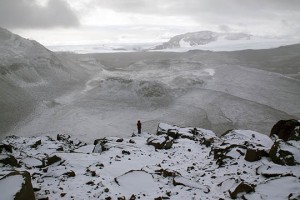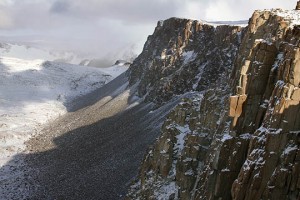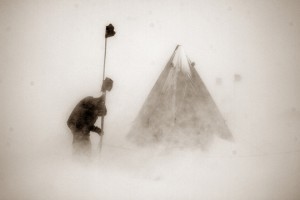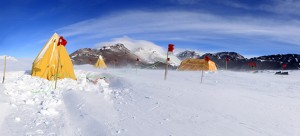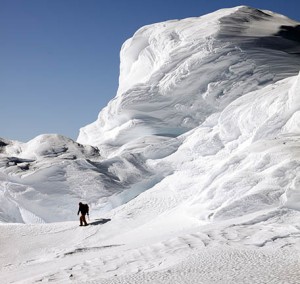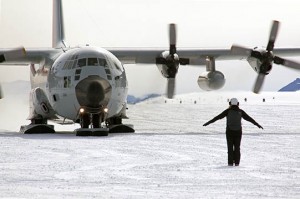Greetings from Antarctica
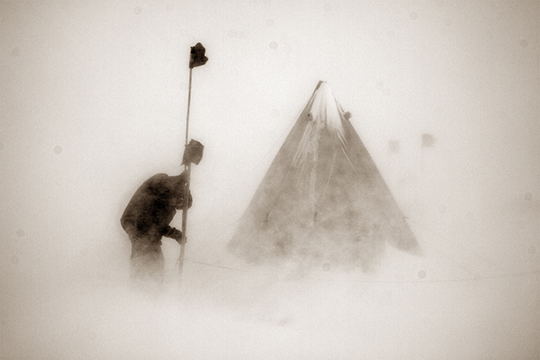
A special story and report from our friend Gordon Bromley at the South Pole
We usually publish stories like Gordon’s on our Stories page, Click Here, but as Gordon has again given us such a comprehensive review, and has offered us an insight into the work of an Antarctic scientist, we thought the news section would be a great way to share this information and the stunning pictures he has sent. So below is the email from Gordon.
photo by Gorden Bromley
Dear Buffalo folk,
Greetings from Antarctica! My name is Gordon Bromley and I’m currently heading a US National Science Foundation-funded investigation into the long-term stability of the East Antarctic Ice Sheet in a warming climate. This work has my team of geologists running around the upper Transantarctic Mountains in search of glacial moraines from the Pliocene and Miocene warm periods, which we will then date with some rather fancy new geochemical techniques to determine whether or not the ice sheet is vulnerable to global warming. Having just returned to McMurdo Station from our remote field camp, I thought you’d be interested and pleased to hear how your clothing performed out there: in a word, superbly. I’ve contacted you before, generally regarding clothing for my children and whether your products are available in the US, where I currently live (from Cumbria originally), but since then I have been putting my own Buffalo smocks, jackets, and salopettes through their paces quite rigorously in some extreme environments. For example, down here I was using the Mountain Shirt and High Altitude salopettes for four weeks straight, in temperatures ranging from -15°C to -40°C and some pretty hefty wind storms. I’d put a Buffalo belay jacket over the shirt when things got really cold. Some of that time I was climbing exposed mountain ridges, and thus was being active, but a lot of time was spent collecting rock samples, taking notes, riding a snowmobile, etc., and therefore relatively stationary. Since my team is from the US I was the only one with the Buffalo clothing, but I was by far the most comfortable, even without a base layer! All these fancy lightweight down jackets my colleagues were wearing did not compare, especially when the wind was cranking, resulting in some cold scientists. Similarly, I took the smock and belay jacket to Greenland last year for a project on the ice sheet there. In those warmer conditions, the ventilation system was pretty critical to my comfort, allowing me to regulate without having to shed or don extra layers, which is fairly important when one is lugging drills, rock hammers, and bags of rocks around the mountains – every gram counts.
I know your garments are designed for tough climates and terrains, but maybe you weren’t aware of how useful they are in the pursuit of science, being light, durable, and effective? Mine go to the tropical Andes (>6000 m), the poles, and the dampest Scottish corries, where we’re now conducting research (on An Teallach, actually) into abrupt climate change. The latter was especially enlightening, for I’d never actually used the Buffalo system for the driving rain and sleet for which it was apparently designed, and so I was amazed that the wetness never actually reached my skin, being driven back out by my own heat. Unfortunately, I was wearing Patagonia trousers at the time and so my legs were soaked and frozen, but you can’t have everything. Beyond science, I routinely take your clothing ice climbing in New England, where the weather can be severe, and even took it, inadvertently, to the emergency room in 2014 when I took a fall from an ice route in Maine. Having fractured a vertebrae, the medics had to cut my Tecmax shirt off me, but in my narcotic-induced haze I clearly recall them being pretty interested in what it was they were “disassembling” and what the chest strap was for, and why I wasn’t wearing anything underneath! I test your products pretty thoroughly, you see. Ultimately, all this has led to a growing interest among my US colleagues and climbing acquaintances in the clothing, how it works, from where it can be obtained, and so on. What should I tell them? Do you have plans to distribute further afield? Can it be done without sacrificing the inherent quality of the garments?
I do hope this input proves useful. I only came to Buffalo clothing about 7 years ago but have since taken it all over the world and given it hell. If you’re at all interested in hearing about the science it helps me do, I’d be thrilled to expand on that. And should you ever need product testing in the environments I call my laboratory, just drop me a line. I shall be heading to Scotland in spring, the Peruvian Andes in summer, and back down here next November, and can guarantee a good bashing. Finally, I’m enclosing some photographs of Buffalo-in-Antarctica (and elsewhere) that you are welcome to stick on your website if you like.
With thanks and best wishes from Antarctica,
Gordon
photos by Gorden Bromley
photos by Chris Simmons
photos by Jayson Nissen
photo by Kurt Rademaker
After talking to Gordon he has very kindly written a report on what an active research scientist actually does on a day to day basic, when out in the field and what the conditions are like to actually live in. It makes very interesting reading. There are also a few links to the research he publishes.
Antarctic Report 2015, by Gordon Bromley
How will the largest ice sheet on Earth – the East Antarctic Ice Sheet (~14,000,000 km2) – respond to human-induced global warming? Will this continent-sized glacier melt into the ocean, raising sea level by 55 m and displacing countless millions, or is it relatively invulnerable to the magnitude of climate change predicted for the coming centuries? As global warming accelerates, such questions are being asked with increasing urgency, yet the probable future of the East Antarctic Ice Sheet remains hotly debated. Some scientists argue that the ice sheet is inherently unstable, and thus liable to melt, while others cite evidence for it having persisted throughout previous warm periods, including the Pliocene (about 5 to 2.5 million years ago). Still others suggest the ice sheet grows when the climate warms, due to enhanced snowfall. Clearly, the debate is far from resolved.
To help tackle this problem, our team of geologists from the University of Maine and Berkeley Geochronology Center, both in the U.S., headed to the central Transantarctic Mountains during the 2015–16 Antarctic summer to begin researching the behaviour of the East Antarctic Ice Sheet during past times of global warmth. If we know how Antarctica responded to previous warm periods, we’ll be better positioned to project its greenhouse future. Our goals were to identify relict glacial landforms, such as moraines, that were deposited at the ice sheet margin and to collect samples in order to date these landforms. We will then use these geologic data to reconstruct the presence – or absence – of the East Antarctic Ice Sheet during the Pliocene warm period, when the Earth was last as warm as it is expected to be by the end of the 21st Century.
So what do these glacial deposits look like, and how do we tap the records they hold? Perhaps the easiest, if least glamorous, way to envisage the moraines of the East Antarctic Ice Sheet is to think of bathtub rings. In our case, the bathtub represents the Transantarctic Mountains, the water the ice sheet, and the rings the moraines. Instead of grimy residue, however, these moraines comprise boulders, sand, and gravel transported by the glacier and dumped along its margins. As the ice sheet waxes and wanes over countless millennia, the ice edge advances and retreats up and down the adjacent mountains, leaving behind series of rubble ridges (see photo) that we can use as a geologic yardstick.
Relict moraine ridges of the East Antarctic Ice Sheet
To determine when the moraines were deposited, and thus when the ice sheet was present, we use a technique called cosmogenic surface-exposure dating that, although a mouthful to say, is relatively straightforward in principal. Our planet is constantly being bombarded by a cascade of radiation from outer space (cosmic rays), which, by the time it reaches the Earth’s surface, consists primarily of high-energy neutrons. Passing unimpeded through ‘soft’ objects like humans, the physical impact of these neutrons on rocks produces rare nuclides such as Beryllium-10 and Helium-3, which accumulate inside minerals over time. In our work, this process serves as a kind of stopwatch: when a boulder falls out of the glacier margin, it is exposed for the first time to cosmic rays and ‘cosmogenic nuclides’ begin to accumulate. If we measure the concentration of such nuclides in a glacial boulder, we can calculate how long it has been exposed and, thus, when the ice sheet was nearby. In practice, this approach involves collecting fist-sized samples of rock with hammer and chisel, which is a great way of staying warm when it’s -30°C and blowing hard, followed by a lot of convoluted chemistry back in the lab.
This year’s field sites included Roberts Massif (3090 m) and Otway Massif (3200 m), two mountains near the heads of the Shackleton and Beardmore Glaciers, where the East Antarctic Ice Sheet abuts the Transantarctic Mountains and well-preserved moraines are abundant. These are ancient, windswept landscapes of white sandstone shot through with sills of black gabbro, where high plateaux have been carved into peaks and arêtes by long-gone alpine glaciers (the climate is now too cold and dry for glaciers to be erosive) and where the rocks have never felt the power of rain (see photo).
Classic central Transantarctic Mountains scenery at Roberts Massif
Dropped off by a Twin Otter ski plane on the 7th December, we became the first humans to wander these slopes – a rare distinction nowadays – and settled in for a month of intensive mapping and sampling. Our accommodations were two robust Scott tents (an Antarctic icon) and an Arctic Oven kitchen tent, each of which was held down against the wind by a vast rigging of guy lines, heavily piled snow, and a measure of optimism . The Transantarctic Mountains are notorious for katabatic winds – gravity-driven air currents cascading off the ice sheet – and this season was no exception, with a windstorm holding us at bay for three days as the horizon was blotted out by drifting snow (see photo).
Chris Simmons linking tents with a safety rope during a katabatic wind storm, Otway Massif
Camp at Otway Massif, 85 degrees south
The ice-fluted summit of Roberts Massif, Christmas Day 2015
While the overarching theme of our field work is undeniably scientific, the greatest challenges are rather more domestic: the day-to-day tasks necessary to keep a small team safe, warm, and operational. Days begin with a radio check-in to the U.S. base at McMurdo, followed by the melting of copious amounts of snow for water and the preparation of breakfast. And since this is ‘aeroplane camping’, the offerings at mealtimes are plentiful and surprisingly luxurious: for example, cheesy bagels for breakfast and perhaps a fine vegetable curry for tea, with enough chocolate on hand to sink a battleship. It’s all a far cry from the hoosh and sledging biscuits of the Heroic Age, and it’s just as well, for I typically find myself eating three times as much as normal just to keep warm. During the day we explore hillsides and corries in the search for glacial deposits with a story. A typical sampling scene comprises a figure hunched over a boulder, hammering away with a carbide-tipped chisel, whilst another measures the horizon with a clinometer to ascertain the local flux of cosmic rays . Someone else is taking notes on the site, while a fourth seeks out more suitable rocks to bash. In the background, a cumbersome differential GPS is measuring the site’s elevation and position, both of which are critical data in calculating surface-exposure ages. All of this is done in the dry, cold, and windy world of the upper Transantarctic Mountains, where, on especially severe days, the sheer amount of clothing can make it feel one is walking on Mars (our red-tinted ski goggles reinforce this illusion). Nonetheless, it is surprising just how quickly our bodies adjust and after a fortnight or so, on calm days, the place can feel downright pleasant. Even sleeping in perpetual sunlight becomes easy, though circadian rhythms do become a little distorted; working ‘til 3 AM, sleeping until noon, the whole cycle shifts gradually.
Our season ended on the 30th December and, as anyone who enjoys wild landscapes can attest, the return to humanity is a little brutal. People, noise, smells, and to-do lists are all in stark contrast to the turbulent serenity of our natural laboratory, and the transition this year was very rapid indeed, thanks to the efforts of the U.S. programme’s ‘Fixed Wing Ops,’ who oversaw our transportation(see photo).
Skier 491 arrives at Shackleton Camp, our jumping-off point for Otway and Roberts Massif
Now, back in Maine, it’s time to let our brains thaw out, collect thoughts, and prepare for the coming storm of lab work: nine wooden boxes filled with 169 rock samples, each one destined to be crushed, pulverised, leached in hydrofluoric acid, and combusted in a mass spectrometer. All in the name of science.
This work is funded by the U.S. National Science Foundation Office of Polar Programs. You can follow our progress on our laboratory website, watch a pre-season science interview with Gordon Bromley here, and view entries from the 2015–16 field blog here. There is also a link to Gordon’s own website showing his photography and art work, here.
Buffalo Systems Ltd are not responsible for any material contained in external links on our website.
